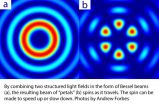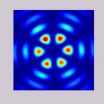INFORMATION:
¹The idea was conceived by Forbes who led the collaboration with Christian Schulze and Michael Duparré (University of Jena, Germany), Ronald Rop (Eggerton University, Kenya), and Filippus Roux and Angela Dudley (Council for Scientific and Industrial Research, South Africa).
Light in a spin
Researchers demonstrate angular accelerating light
2015-04-15
(Press-News.org) Light must travel in a straight line and at a constant speed, or so the laws of nature suggest. Now, researchers at the University of the Witwatersrand in Johannesburg have demonstrated that laser light traveling along a helical path through space, can accelerate and decelerate as it spins into the distance.
This is the first time that angular acceleration has been observed with light, and is therefore likely to lead to new applications using these structured light fields.
The results are contained in a research paper by Professor Andrew Forbes from the Wits School of Physics and his collaborators¹, published online this week in the journal, Physical Review A. Titled: Accelerated rotation with orbital angular momentum modes, the work has also been selected as a highlighted paper by the editors.
Forbes, who joined the Wits School of Physics in March this year, is heading up the new Structured Light Laboratory that focuses on creating custom light fields using digital holograms. The research group creates complex light that exhibits interesting physical properties, which they exploit for a range of applications.
Previously, Forbes and his collaborators have shown that light could be made to spin. In this recent work they demonstrated the first realisation of angular accelerating light and showed that light could also be made to accelerate and decelerate. This acceleration can be controlled with a single parameter that is readily tuned with a digital hologram written to a standard LCD screen, much like your LCD television at home, but just a much smaller version.
"Our angular accelerating fields rely on combinations of orbital angular momentum - so-called twisted light," says Forbes. Light carrying orbital angular momentum is created by twisting the wave-front of light into a helical shape, forming a spiral. Usually this twist in the light's wave-front is smooth, like a spiral staircase with regular steps. "Our novelty was to realise that by twisting the helicity of these beams in a non-linear fashion, the result would be a propagation dependent angular velocity," he explains. In other words, the light spins at a non-constant speed, resulting in angular acceleration.
In fact, the light speeds up and slows down as it travels, periodically switching from one mode to the other. Following its helical path through space, the helix appears to wind up very tightly as it accelerates, and winds down very loosely as it decelerates. It is intriguing that by "twisting the twist", nature provides an additional momentum to the field causing it to accelerate as it spins.
The team expects this new optical field to be of interest as a tool to study some fundamental physical processes with light, as well as a tool in optically driving micro-fluidic flow.
ELSE PRESS RELEASES FROM THIS DATE:
E-cigarette use is not risk-free
2015-04-15
E-cigarettes are not without health risks for people who vape or for bystanders. This is one of the conclusions from a new risk assessment report from the Norwegian Institute of Public Health (NIPH).
The report has only considered e-cigarettes with nicotine since there has been very little research about e-cigarettes without nicotine.
In summary
Since e-cigarettes supply nicotine in the same quantities as cigarette smoking, the same harmful effects from nicotine can be expected.
The vapour from e-cigarettes contains so much nicotine that bystanders can ingest ...
Surveys miss majority of poisonings, underestimate cost by billions
2015-04-15
Health surveys may underestimate the number of poisonings in the United States by 60 percent to 90 percent, according to a report in the journal Clinical Toxicology by University of Illinois at Chicago researchers.
As of 2009, poisonings became the leading cause of fatal injury in the U.S., surpassing transportation-related deaths and gun-related deaths.
The researchers analyzed hospital billing records, patient demographics, exposure information, and outcomes for Illinois hospital visits related to poisonings in 2010. They also looked at poisoning incidence data from ...
Iowa State anthropologist finds female chimps more likely to use tools when hunting
2015-04-15
AMES, Iowa - It was a discovery that changed what researchers knew about the hunting techniques of chimpanzees. In 2007, Jill Pruetz first reported savanna chimps at her research site in Fongoli, Senegal, were using tools to hunt prey. That alone was significant, but what also stood out to Pruetz was the fact that female chimps were the ones predominantly hunting with tools.
It was a point some dismissed or criticized because of the small sample size, but the finding motivated the Iowa State University anthropology professor to learn more. In the years following, Pruetz ...
Scientists develop mesh that captures oil--but lets water through
2015-04-15
COLUMBUS, Ohio--The unassuming piece of stainless steel mesh in a lab at The Ohio State University doesn't look like a very big deal, but it could make a big difference for future environmental cleanups.
Water passes through the mesh but oil doesn't, thanks to a nearly invisible oil-repelling coating on its surface.
In tests, researchers mixed water with oil and poured the mixture onto the mesh. The water filtered through the mesh to land in a beaker below. The oil collected on top of the mesh, and rolled off easily into a separate beaker when the mesh was tilted.
The ...
Study reveals an absence of consistent standards in children's hospital environments
2015-04-15
The sound, light and temperature levels in paediatric hospital wards often vary, highlighting the lack of consistent environmental standards, according to a new study.
The research is being presented today at the 2015 Sleep and Breathing Conference (16 April, 2015).
Children and parents often suffer sleep deprivation when the environment on a ward is disruptive, which can affect disease recovery and quality of life in hospitalised children. There are no general consistent recommendations covering sound, light and temperature levels to help guide hospitals across ...
Disruption of sleep in children could hamper memory processes
2015-04-15
Sleep disordered breathing can hamper memory processes in children, according to a new study.
The research, which will be presented today at the Sleep and Breathing Conference (16 April 2015), found that disrupted sleep had an impact on different memory processes and how children learn.
Eszter Csabi led a team of researchers from the University of Szeged and Eötvös Loránd University in Hungary. They analysed 17 children with sleep disordered breathing aged between 6 and 12 years. They looked at different memory processes compared to a control group ...
Quantum cryptography at the speed of light: Researchers design first all-photonic repeaters
2015-04-15
Imagine having your MRI results sent directly to your phone, with no concern over the security of your private health data. Or knowing your financial information was safe on a server halfway around the world. Or sending highly sensitive business correspondence, without worrying that it would fall into the wrong hands.
Thanks to new research from engineers at the University of Toronto, these types of perfectly secure information exchanges are one step closer to reality. Published this week in Nature Communications, researchers have designed the first all-photonic quantum ...
Children with disabilities can make competent witnesses
2015-04-15
Children with intellectual disabilities--significantly low cognitive functioning coupled with significant deficits in adaptive or everyday functioning--make up 2 to 3 percent of the population, and it's estimated that 1 in 3 children with disabilities experiences some form of maltreatment. However, in many cases, the disclosures of children with intellectual disabilities aren't investigated or taken to court, in part because of concern over whether these children can describe their experiences sufficiently and be believed by juries. A new study has found that children with ...
Infants born prematurely: 2 studies identify routes to better outcomes
2015-04-15
Eleven percent of all births worldwide are preterm, or occurring before 37 weeks of pregnancy, and preterm-related causes of death account for a significant number of infant deaths, as well as long-term neurological disabilities. Efforts are under way, including an initiative by the Eunice Kennedy Shriver National Institute of Child Health and Human Development, to reduce elective deliveries before 39 weeks of pregnancy. Now two new longitudinal studies that appear in the journal Child Development offer insights on how to decrease the problems associated with premature ...
Children who understand others' perspectives found to be more popular among peers
2015-04-15
Preschoolers and school-age children who are good at identifying what others want, think, and feel are more popular in school than their peers who aren't as socially adept. That's the conclusion of a new meta-analysis--a type of study that looks at the results of many different studies--out of Australia.
The study was done at the University of Queensland, Australia, and appears in the journal Child Development.
"Our study suggests that understanding others' mental perspectives may facilitate the kind of interactions that help children become or remain popular," notes ...
LAST 30 PRESS RELEASES:
Heart-brain connection: international study reveals the role of the vagus nerve in keeping the heart young
Researchers identify Rb1 as a predictive biomarker for a new therapeutic strategy in some breast cancers
Survey reveals ethical gaps slowing AI adoption in pediatric surgery
Stimulant ADHD medications work differently than thought
AI overestimates how smart people are, according to HSE economists
HSE researchers create genome-wide map of quadruplexes
Scientists boost cell "powerhouses" to burn more calories
Automatic label checking: The missing step in making reliable medical AI
Low daily alcohol intake linked to 50% heightened mouth cancer risk in India
American Meteorological Society announces Rick Spinrad as 2026 President-Elect
Biomass-based carbon capture spotlighted in newly released global climate webinar recording
Illuminating invisible nano pollutants: advanced bioimaging tracks the full journey of emerging nanoscale contaminants in living systems
How does age affect recovery from spinal cord injury?
Novel AI tool offers prognosis for patients with head and neck cancer
Fathers’ microplastic exposure tied to their children’s metabolic problems
Research validates laboratory model for studying high-grade serous ovarian cancer
SIR 2026 delivers transformative breakthroughs in minimally invasive medicine to improve patient care
Stem Cell Reports most downloaded papers of 2025 highlight the breadth and impact of stem cell research
Oxford-led study estimates NHS spends around 3% of its primary and secondary care budget on the health impacts of heat and cold in England
A researcher’s long quest leads to a smart composite breakthrough
Urban wild bees act as “microbial sensors” of city health.
New study finds where you live affects recovery after a hip fracture
Forecasting the impact of fully automated vehicle adoption on US road traffic injuries
Alcohol-related hospitalizations from 2016 to 2022
Semaglutide and hospitalizations in patients with obesity and established cardiovascular disease
Researchers ‘listen in’ to embryo-mother interactions during implantation using a culture system replicating the womb lining
How changing your diet could help save the world
How to make AI truly scalable and reliable for real-time traffic assignment?
Beyond fragmented markets: A new framework for efficient and stable ride-pooling
Can shape priors make road perception more reliable for autonomous driving?
[Press-News.org] Light in a spinResearchers demonstrate angular accelerating light




